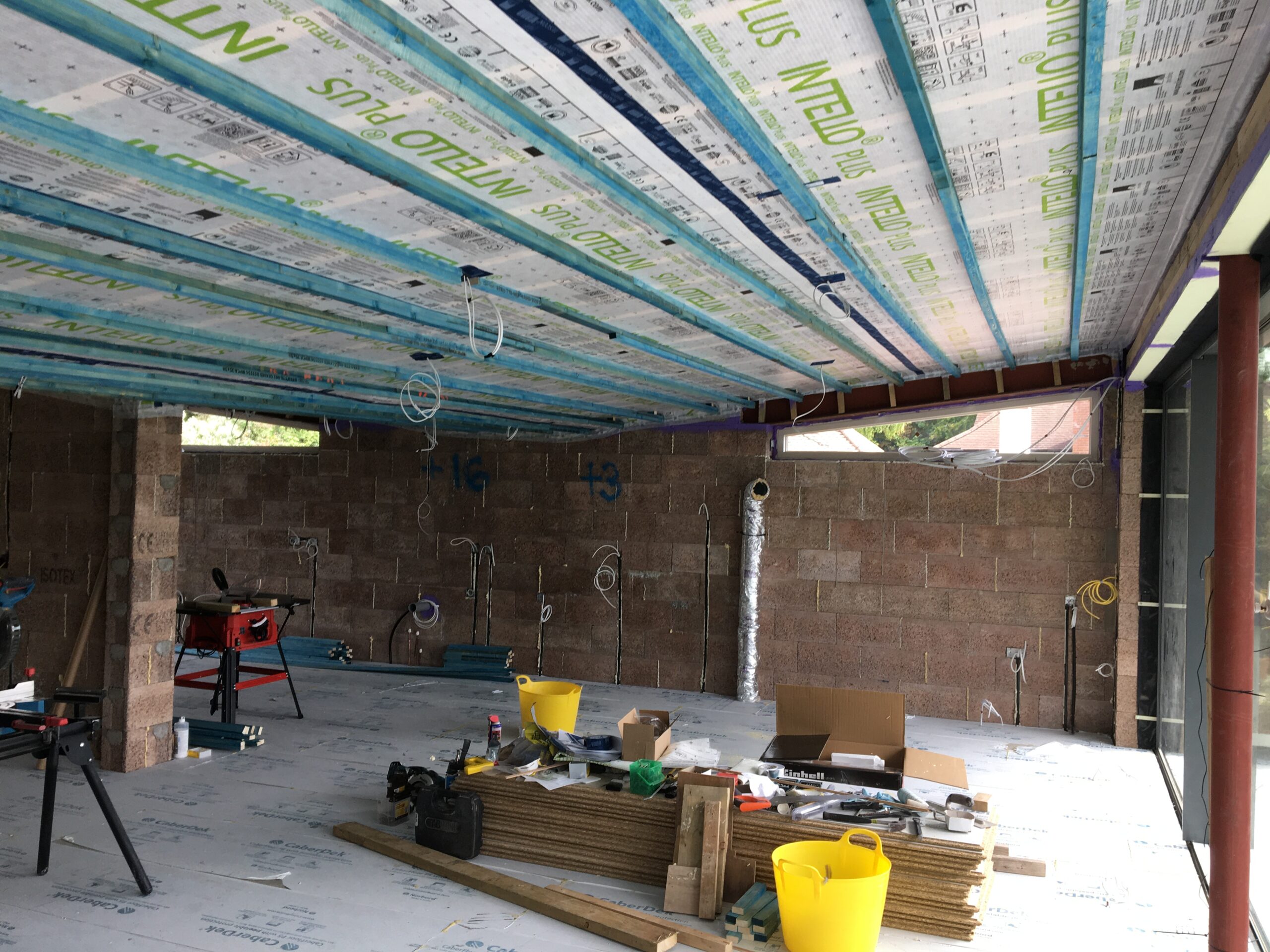There has been a long gap since the last post as we have been heavily involved in working on the house ourselves leaving little time for keeping the blog up to date! We have also managed to get away for 10 days and now catching up again. This update covers a summary of progress over the weeks to mid July.
Graham of G T Electric Services continues to work on the first fix electrics. I will provide full statistics later but we are up to about 3kms of T&E cabling and 2kms of Cat 6 cabling! As mentioned previously, we are installing a smart home set up so each cable has to be run back to the plant room and every Cat 6, which generally provides the control for the system, also has to run to a hub in the plant room. There are therefore no ring mains in the conventional sense. His first fix was largely completed by 15 July.
Harry and Harry of H J Denison have completed the installation of the first fix plumbing. Pipes have sprung up all around the house as they work from bottom to top. The hot water system will be based on the Total Home Environment HPW300 unvented, combined air source heat pump and 300l hot water cylinder. As part of the system, we are installing a Showersave device on each side of the building. This works by using the waste water from the showers and other outlets to pre-warm the water going into the showers, thereby saving some of the energy required to heat the water in the first place. It is, in effect, a small heat exchanger using warm waste water before it disappears into the drains.
On Monday 4 and Tuesday 5 July, Nathan and team of G Q & Sons Roofing returned to apply Polyroof’s Protec product to the balconies as a result of which they are finally fully waterproof and there is no longer a need for Visqueen coverings on site! The Protec system is built up over several layers to ensure that the waterproof covering will stay in good condition for several decades. Ultimately, the balcony decks will be covered in Porcelain tiles set on pedestals which will largely cover the Protec layer.
On Monday 11 July, Scott and Ben of Firth Construction Ltd arrived to inject Warmcell into the roof void between the posi-joists. Warmcell is a cellulose fibre insulation manufactured from recycled newspapers! This has given us a 255mm layer of cellulose plus a 75mm layer of PIR board on the roof, which comfortably exceeds the target u value of 0.1. The bales of cellulose were pushed into a machine which “squirted” them up to the top floor and into the ceiling voids. A very quick operation, it was completed in about 4 hours. Of note, the team who carried out this work mentioned that they normally get at least one “blow-out” where the membrane has not been sealed to the structure properly. They said that this was the first time that they had not had a single seal break and all the credit for this goes to Mrs H who meticulously sealed every crevice!
As I mentioned above, we have also been busy working on the house following the principle of “if it can be seen in the finished product, get a professional; if it will be covered over, then we will have a crack at it“! To that end, over the past 2 weeks, we have:
- installed timber noggins to all of the steels on the top floor to provide fixings for the dry lining
- applied Passive Purple to all cracks, window frames, door frames and any external penetrations to ensure that the fabric of the building is as airtight as possible
- applied insulating foam to any small cracks and gaps to prepare the walls pre-dry-lining and plastering
- installed insulation to the underside of the top floor roof valley gulley comprising a mix of 100mm Recticel PIR board and 100mm Rockwool slab insulation. The combined effect should achieve a u-value of 0.13, which is not quite as good as the target 0.1 but is as good as we can achieve within the parameters of the depth and fall of the valley gulley
- chased in all cable runs on all floors
- levelled all of the window frames with self-levelling screed to ensure that the cills will be level prior to fiitting the cills
- measured and ordered pre-moulded window boards (cills) for all windows from Skirting World
- applied Pro-Clima Intello Plus membrane to the top floor ceiling (supplied by PYC Systems). This is a precursor to injecting Warmcell cellulose insulation to the roof voids (see above) and involved stapling the membrane to the posi joists, taping around all of the joins with the walls and applying grommets to every cable penetration. Incidentally, we used over 3500 staples, applied with a hand stapler. fixing the membrane!
- installed cross battens under the membrane to ensure that there is no sagging once the insulation is injected. These battens were built up to 50mm (a total of 65mm with the plaster board) which allows any lights to be installed without touching the membrane or insulation.
- installed Recticel Deck VQ insulation to the balconies before G Q & Sons arrived to install the Protec layers (see above). Deck VQ is only 60mm deep but is a dense, composite insulation which provide a similar u value to 175mm of PIR board but is also designed to be walked upon
- installed additional 50mm battens to the waterproofed area of the basement
- started to install 100mm Rockwool RGA45 slab acoustic insulation to the ceilings
You may wonder why we have not used predominantly local suppliers. We have, where it makes sense to do so and the relevant skills are available. However, the more specialised equipment tends to be available from national suppliers. Where this is the case, then we have gone to the suppliers and asked for their preferred installer lists. There are 2 reasons for this approach: first, there is no issue with warranties and quality control if you use the supplier’s preferred installers; secondly, “supply and fit” is zero-rated for VAT which means that the installer can supply without charging VAT and it saves having to pay it out and then reclaim at the end of the build.
We will post some photos of the work shortly. In the meantime we have moved onto the drylining and plastering; more to follow in the next update.

